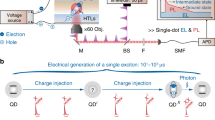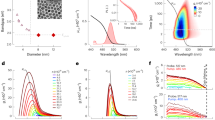Abstract
As a result of quantum-confinement effects, the emission colour of semiconductor nanocrystals can be modified dramatically by simply changing their size1,2. Such spectral tunability, together with large photoluminescence quantum yields and high photostability, make nanocrystals attractive for use in a variety of light-emitting technologies—for example, displays, fluorescence tagging3, solid-state lighting and lasers4. An important limitation for such applications, however, is the difficulty of achieving electrical pumping, largely due to the presence of an insulating organic capping layer on the nanocrystals. Here, we describe an approach for indirect injection of electron–hole pairs (the electron–hole radiative recombination gives rise to light emission) into nanocrystals by non-contact, non-radiative energy transfer from a proximal quantum well that can in principle be pumped either electrically or optically. Our theoretical and experimental results indicate that this transfer is fast enough to compete with electron–hole recombination in the quantum well, and results in greater than 50 per cent energy-transfer efficiencies in the tested structures. Furthermore, the measured energy-transfer rates are sufficiently large to provide pumping in the stimulated emission regime, indicating the feasibility of nanocrystal-based optical amplifiers and lasers based on this approach.
This is a preview of subscription content, access via your institution
Access options
Subscribe to this journal
Receive 51 print issues and online access
$199.00 per year
only $3.90 per issue
Buy this article
- Purchase on Springer Link
- Instant access to full article PDF
Prices may be subject to local taxes which are calculated during checkout




Similar content being viewed by others
References
Alivisatos, A. P. Semiconductor clusters, nanocrystals, and quantum dots. Science 271, 933–937 (1996)
Murray, C. B., Norris, D. J. & Bawendi, M. G. Synthesis and characterization of nearly monodisperse CdE (E = S, Se, Te) semiconductor nanocrystallites. J. Am. Chem. Soc. 115, 8706–8715 (1993)
Bruchez, M., Moronne, M., Gin, P., Weiss, S. & Alivisatos, A. P. Semiconductor nanocrystals as fluorescent biological labels. Science 281, 2013–2016 (1998)
Klimov, V. I. et al. Optical gain and stimulated emission in nanocrystal quantum dots. Science 290, 314–317 (2000)
Next-Generation Lighting Initiative http://lighting.sandia.gov/Xlightinginit.htm#snlngli
Colvin, V., Schlamp, M. & Alivisatos, A. Light-emitting diodes made from cadmium selenide nanocrystals and a semiconducting polymer. Nature 370, 354–357 (1994)
Schlamp, M. C., Peng, X. G. & Alivisatos, A. P. Improved efficiencies in light emitting diodes made with CdSe(CdS) core/shell type nanocrystals and a semiconducting polymer. J. Appl. Phys. 82, 5837–5842 (1997)
Coe, S., Woo, W.-K., Bawendi, M. & Bulovic, V. Electroluminescence from single monolayers of nanocrystals in molecular organic devices. Nature 420, 800–803 (2002)
Dabbousi, B. O. et al. (CdSe)ZnS core-shell quantum dots: synthesis and characterization of a size series of highly luminescent nanocrystallites. J. Phys. Chem. 101, 9463–9475 (1997)
Koleske, D. D. et al. Improved brightness of 380 nm GaN light emitting diodes through intentional delay of the nucleation island coalescence. Appl. Phys. Lett. 81, 1940–1942 (2002)
Basko, D., La Rocca, G. C., Bassani, F. & Agranovich, V. M. Förster energy transfer from a semiconductor quantum well to an organic material overlayer. Eur. Phys. J. B 8, 353–362 (1999)
Klimov, V. I. & McBranch, D. W. Femtosecond 1P-to-1S electron relaxation in strongly confined semiconductor nanocrystals. Phys. Rev. Lett. 80, 4028–4031 (1998)
Xu, S., Mikhailovsky, A. A., Hollingsworth, J. A. & Klimov, V. I. Hole intraband relaxation in strongly confined quantum dots: Revisiting the “phonon bottleneck” problem. Phys. Rev. B 65, 045319 (2002)
Klimov, V. I. Optical nonlinearities and ultrafast carrier dynamics in semiconductor nanocrystals. J. Phys. Chem. B 104, 6112–6123 (2000)
Klimov, V. I., Mikhailovsky, A. A., McBranch, D. W., Leatherdale, C. A. & Bawendi, B. G. Quantization of multiparticle Auger rates in semiconductor quantum dots. Science 287, 1011–1013 (2000)
Nakamura, S. & Fasol, G. The Blue Laser Diode: GaN Based Light Emitters and Lasers (Springer, Berlin Heidelberg, Germany, 1997)
Wu, L. W. et al. Influence of Si-doping on the characteristics of InGaN-GaN multiple quantum-well blue light emitting diodes. IEEE J. Quantum Electron. 38, 446–450 (2002)
Bidnyk, S. et al. High-temperature stimulated emission in optically pumped InGaN/GaN multiquantum wells. Appl. Phys. Lett. 72, 1623–1625 (1998)
Acknowledgements
This work was supported by Los Alamos LDRD Funds and the Office of Basic Energy Sciences, Office of Science, US Department of Energy. Sandia National Laboratories is a multiprogram laboratory operated by Sandia Corporation, a Lockheed Martin Company, for the Department of Energy.
Author information
Authors and Affiliations
Corresponding authors
Ethics declarations
Competing interests
The authors declare that they have no competing financial interests.
Supplementary information
Supplementary Information
Calculation of the QW-NC energy transfer rate. (PDF 128 kb)
Rights and permissions
About this article
Cite this article
Achermann, M., Petruska, M., Kos, S. et al. Energy-transfer pumping of semiconductor nanocrystals using an epitaxial quantum well. Nature 429, 642–646 (2004). https://doi.org/10.1038/nature02571
Received:
Accepted:
Issue Date:
DOI: https://doi.org/10.1038/nature02571
This article is cited by
-
Essential role of momentum-forbidden dark excitons in the energy transfer responses of monolayer transition-metal dichalcogenides
npj 2D Materials and Applications (2023)
-
Resonant exciton transfer in mixed-dimensional heterostructures for overcoming dimensional restrictions in optical processes
Nature Communications (2023)
-
Tailored growth of single-crystalline InP tetrapods
Nature Communications (2021)
-
Unraveling energy and charge transfer in type-II van der Waals heterostructures
npj Computational Materials (2021)
-
Giant enhancement of optical nonlinearity in two-dimensional materials by multiphoton-excitation resonance energy transfer from quantum dots
Nature Photonics (2021)
Comments
By submitting a comment you agree to abide by our Terms and Community Guidelines. If you find something abusive or that does not comply with our terms or guidelines please flag it as inappropriate.



